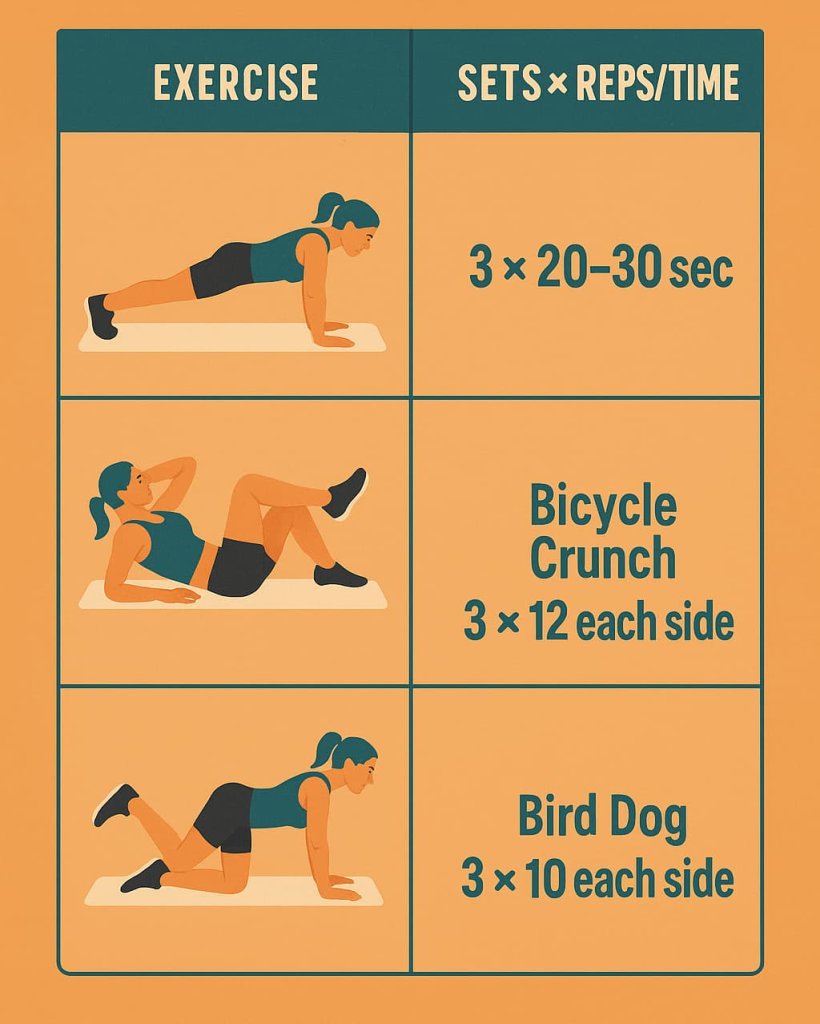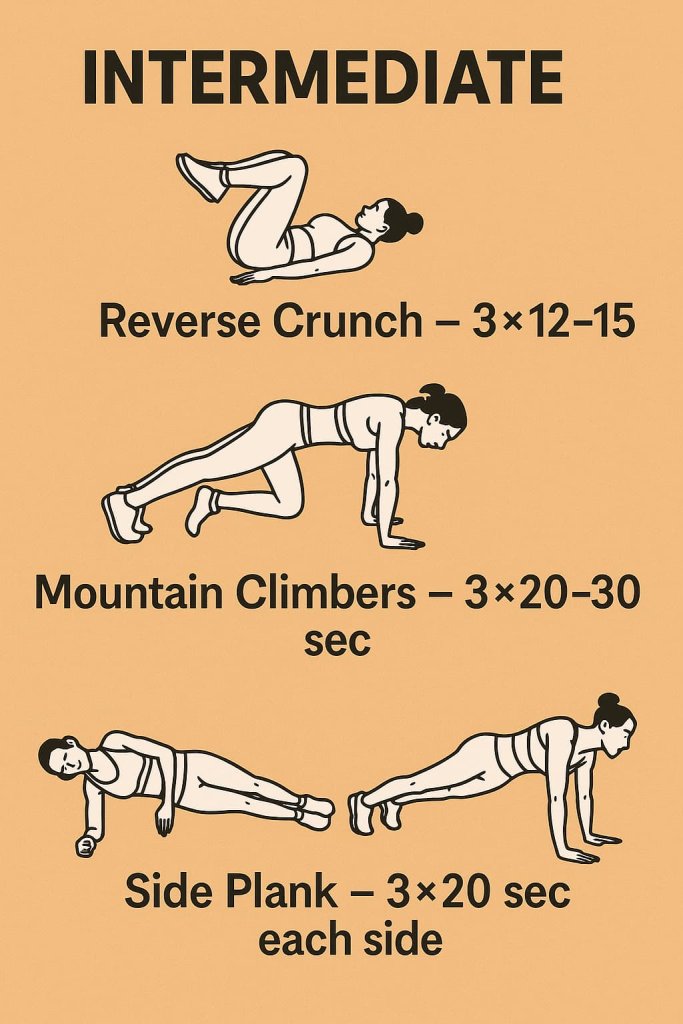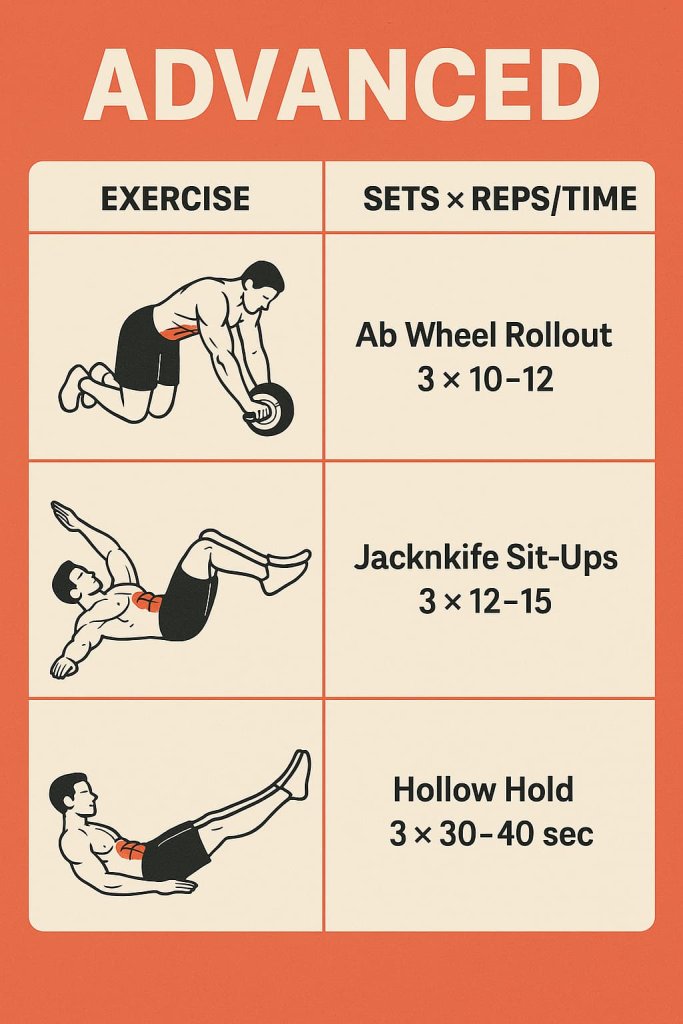The best ab workout routine is one that trains your entire core — including your upper abs, lower abs, obliques, and deep stabilizers. A strong core improves balance, posture, and athletic performance while protecting your spine from injuries.
Many people want to know the exact ab routine to follow. That’s why we’ll start with a sample ab workout plan you can use right away, and then dive into the science, benefits, and detailed exercise breakdowns so you understand why these moves work.
👉 Quick note: No ab workout alone will “burn belly fat.” Visible abs require a combination of strength training, cardio, and a clean diet (Marie Claire, 2025).
Sample Ab Workout Routine (Beginner to Advanced)
Here’s a progressive workout plan that covers all levels. Start with the beginner routine and move up as your strength improves.
Beginner Ab Workout Routine
| Exercise | Sets × Reps/Time |
|---|---|
| Plank Hold | 3 × 20–30 sec |
| Bicycle Crunch | 3 × 12 each side |
| Bird Dog | 3 × 10 each side |

Intermediate Ab Workout Routine
| Exercise | Sets × Reps/Time |
|---|---|
| Reverse Crunch | 3 × 12–15 |
| Mountain Climbers | 3 × 20–30 sec |
| Side Plank | 3 × 20 sec each side |

Advanced Ab Workout Routine
| Exercise | Sets × Reps/Time |
|---|---|
| Ab Wheel Rollout | 3 × 10–12 |
| Jackknife Sit-Ups | 3 × 12–15 |
| Hollow Hold | 3 × 30–40 sec |

✅ This workout takes just 10–15 minutes. Beginners should start with the top three moves, intermediates can mix in the next three, and advanced lifters can complete the full sequence.
Why Core Training Matters
Your abs do much more than look good in the mirror. Training your core builds:
- Better posture – prevents slouching and back pain
- Stronger lifts – improves performance in squats, deadlifts, and overhead presses
- Injury prevention – protects your spine and hips
- Daily functionality – bending, twisting, lifting all become easier
- Balance and stability – essential for athletes and older adults alike
Anatomy of the Core
Understanding your core helps you target it effectively:
- Rectus Abdominis – the “six-pack” muscle in the front
- Obliques (Internal & External) – located on the sides, help with twisting and bending
- Transverse Abdominis – deep stabilizing muscle, acts like a natural weight belt
- Erector Spinae & Lower Back – keeps the spine upright and stable
- Hip Flexors & Pelvic Floor – crucial for core stability and lower ab activation
👉 A complete ab workout should hit all these areas, not just the front abs.
Best Ab Exercises for Core Strength
1. Plank Variations
Planks train the deep core muscles and improve bracing strength better than crunches (Times of India, 2025).
- Standard Plank
- Side Plank
- High Plank Shoulder Taps
2. Bicycle Crunches
Ranked by the American Council on Exercise (ACE) as the #1 ab exercise for muscle activation. Targets both rectus abdominis and obliques.
3. Hollow Hold
A Pilates staple that builds static strength and endurance. Keep lower back pressed into the ground.
4. Bird Dog & Dead Bug
Excellent beginner-friendly moves that improve coordination and protect the spine (The Sun, 2025).
5. Mountain Climbers
A cardio-core hybrid that raises your heart rate while working abs dynamically.
6. Ab Wheel Rollouts
Advanced, challenging, and one of the best for full anterior core activation.
Best Lower Ab Exercises
Lower abs are the toughest to target. Try:
- Reverse Crunches – lift hips for full contraction
- Leg Raises – focus on controlled movement
- Scissor Kicks – builds endurance
- Jackknife Sit-Ups – explosive and effective
- Box Plank Up-Downs – functional and dynamic
(Source: Marie Claire, 2025)
Standing Ab Exercises (No Floor Needed)
Not a fan of crunches? Standing core work is functional and spine-friendly.
Examples:
- Standing Oblique Crunches
- Resistance Band Woodchoppers
- Dumbbell Side Bends
- Knee-to-Elbow Twists
👉 These improve balance, stability, and coordination (Tom’s Guide, 2025).
Weekly Ab Workout Plan
Here’s how you can structure your training week:
- Monday – Beginner/Intermediate Ab Routine (10–12 min)
- Wednesday – Standing Abs + Cardio (15 min)
- Friday – Advanced Core Circuit (15 min)
👉 Remember: Your abs also get worked indirectly during compound lifts like squats, deadlifts, and push-ups.
Common Myths About Ab Training
- ❌ “Crunches are enough.” → Core needs variety.
- ❌ “Daily ab workouts give faster results.” → Rest is required for growth.
- ❌ “You can spot reduce belly fat.” → Fat loss happens body-wide, not in one spot.
Nutrition Tips for Visible Abs
Even the best routine won’t show results without diet discipline:
- Create a slight calorie deficit
- Eat lean protein to build muscle
- Include fiber-rich carbs (vegetables, oats, quinoa)
- Drink enough water
- Cut excess sugar and alcohol
👉 Abs are truly revealed in the kitchen.
FAQ: Ab Workout Routine
1. How often should I train abs?
2–3 times per week is ideal.
2. Can ab workouts alone give me a six-pack?
No. You also need fat loss through diet and cardio.
3. What’s the best beginner ab workout?
Plank, bicycle crunch, and bird dog are safe and effective.
4. How long does it take to see results?
Strength gains in 3–4 weeks; visible definition depends on body fat.
5. Do I need equipment?
No, but tools like an ab wheel or resistance bands can help.
6. Are planks better than sit-ups?
Yes — planks activate more muscles and reduce spine stress.
7. What’s the best move for lower abs?
Reverse crunches and leg raises are most effective.
Conclusion
A complete ab workout routine builds more than six-pack muscles — it develops stability, athleticism, and everyday strength.
To maximize results:
- Train abs 2–3 times per week
- Mix static holds, dynamic moves, and functional standing abs
- Combine with strength training, cardio, and clean nutrition
👉 Start with the beginner routine above, stay consistent, and progress over time. In just weeks, you’ll feel a stronger, leaner, and more powerful core.
